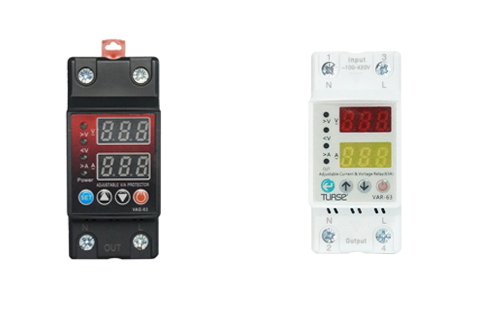Feb 11,2025
Editer: Sherry
In the complex electrical systems that power our daily lives and industrial operations, current voltage protectors play a crucial role in safeguarding electrical equipment from potential damage caused by over - current and over - voltage conditions. Understanding how these protectors detect such abnormal situations is essential for ensuring the reliability and safety of electrical installations.

1. Detection of Over - current
1.1 Using Current Transformers (CTs)
One of the most common methods for detecting over - current is through the use of current transformers. CTs are designed to step down the high current in the main circuit to a much lower, measurable value. They consist of a primary winding connected in series with the main electrical conductor and a secondary winding. The current in the secondary winding is proportional to the current in the primary winding.
When the current in the main circuit exceeds the normal range and enters the over - current state, the current in the secondary winding of the CT also increases proportionally. This increased secondary current is then fed into the control circuit of the current voltage protector. The control circuit is equipped with a comparison mechanism. It compares the measured secondary current value with a pre - set threshold value. If the measured value exceeds the threshold, it indicates an over - current situation, and the protector is triggered to take appropriate actions, such as tripping a circuit breaker or sending an alarm signal.
1.2 Hall - effect Sensors
Hall - effect sensors are another type of device used for over - current detection. These sensors operate based on the Hall effect, which states that when a current - carrying conductor is placed in a magnetic field perpendicular to the direction of the current, a voltage difference (Hall voltage) is generated across the conductor.
In the context of over - current detection, a Hall - effect sensor is placed near the electrical conductor. As the current in the conductor changes, the magnetic field around it also changes, and the Hall - effect sensor measures this change in the magnetic field. By measuring the Hall voltage, the sensor can determine the magnitude of the current flowing through the conductor. Similar to the CT - based method, when the measured current value exceeds the pre - set limit, the current voltage protector's control circuit is activated, and protective measures are initiated.
2. Detection of Over - voltage
2.1 Voltage Transformers (VTs)
Voltage transformers, also known as potential transformers, are commonly used to detect over - voltage. VTs are designed to step down the high voltage in the main circuit to a lower, manageable voltage level for measurement purposes. They have a primary winding connected across the high - voltage source and a secondary winding. The voltage in the secondary winding is proportional to the voltage in the primary winding.
When the voltage in the main circuit rises above the normal operating range and reaches an over - voltage condition, the voltage in the secondary winding of the VT also increases proportionally. This secondary voltage is then input into the control circuit of the current voltage protector. The control circuit compares this measured secondary voltage with a pre - determined reference voltage. If the measured voltage exceeds the reference voltage, it signals an over - voltage situation, and the protector responds accordingly, such as disconnecting the circuit to protect the connected equipment.
2.2 Zener Diodes
Zener diodes are semiconductor devices with a unique property: they maintain a nearly constant voltage across their terminals when reverse - biased above a certain breakdown voltage, known as the Zener voltage. In over - voltage detection circuits, Zener diodes are used as voltage reference elements.
The input voltage from the electrical circuit is applied to a circuit that includes a Zener diode. Under normal voltage conditions, the Zener diode does not conduct significantly. However, when the input voltage exceeds the Zener voltage, the Zener diode starts to conduct, and the resulting change in the circuit's electrical parameters (such as current or voltage) is detected by the control circuit of the current voltage protector. Once the over - voltage condition is detected, the protector can take actions to protect the electrical system.
In conclusion, current voltage protectors use a variety of techniques and components to detect over - current and over - voltage situations accurately. These detection methods ensure that electrical equipment is protected from the harmful effects of abnormal electrical conditions, contributing to the overall reliability and safety of electrical systems in both residential and industrial settings.